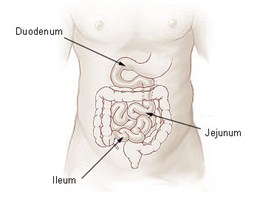Short Bowel Syndrome
Short bowel syndrome is a group of problems related to poor absorption of nutrients that typically occurs in people who have had half or more of their small intestine removed. The small intestine and the large intestine, also called the colon, make up the bowel. The small intestine is where most digestion of food and absorption of nutrients occur. People with short bowel syndrome cannot absorb enough water, vitamins, and other nutrients from food to sustain life.
 The bowel is made up of the small and large intestines. The small intestine includes three sections-the duodenum, jejunum, and ileum.
The bowel is made up of the small and large intestines. The small intestine includes three sections-the duodenum, jejunum, and ileum.
What causes short bowel syndrome?
The main cause of short bowel syndrome is surgical removal of half or more of the small intestine to treat intestinal diseases, injuries, or defects present at birth.
In newborns, short bowel syndrome may occur following surgery to treat conditions such as
- necrotizing enterocolitis, a condition that occurs in premature infants and leads to the death of bowel tissue
- congenital defects of the bowel, such as midgut volvulus, omphalocele and gastroschisis, jejunoileal atresia, internal hernia, and congenital short bowel
- meconium ileus, a condition associated with cystic fibrosis
In children and adults, short bowel syndrome may occur following surgery to treat conditions such as
- intussusception, a condition in which part of the intestine folds into another part of the intestine
- Crohn's disease, an inflammatory bowel disease
- bowel injury from loss of blood flow due to a blocked blood vessel
- bowel injury from trauma
- cancer and damage to the bowel caused by cancer treatment
Short bowel syndrome can also be caused by disease or injury that prevents the small intestine from functioning as it should despite a normal length.
What are the signs and symptoms of short bowel syndrome?
Diarrhea is the main symptom of short bowel syndrome. Diarrhea can lead to dehydration, malnutrition, and weight loss. These problems can be severe and can cause death without proper treatment.
Other symptoms may include
- cramping
- bloating
- heartburn
- weakness and fatigue
Specific nutrient deficiencies may occur depending on what sections of the small intestine were removed or are not functioning properly. Sites of nutrient absorption in the small intestine are
- the duodenum, the first section of the small intestine, where iron is absorbed
- the jejunum, the middle section of the small intestine, where carbohydrates, proteins, fat, and vitamins are absorbed
- the ileum, the last section of the small intestine, where bile acids and vitamin B12 are absorbed.
People with short bowel syndrome are also at risk for developing food sensitivities.
How is short bowel syndrome treated?
The main treatment for short bowel syndrome is nutritional support. Treatment may involve use of oral rehydration solutions, parenteral nutrition, enteral nutrition, and medications. Oral rehydration solutions consist of sugar and salt liquids. Parenteral nutrition delivers fluids, electrolytes, and liquid nutrients into the bloodstream intravenously-through a tube placed in a vein. Enteral nutrition delivers liquid food to the stomach or small intestine through a feeding tube.
Specific treatment depends on the severity of the disease:
-
Mild short bowel syndrome treatment involves eating small, frequent meals; taking fluid and nutritional supplements; and using medications to treat diarrhea.
-
Moderate short bowel syndrome treatment is similar to that for mild disease with the addition of intravenous fluid and electrolyte supplements as needed.
-
Severe short bowel syndrome treatment involves use of parenteral nutrition and oral rehydration solutions. Patients may receive enteral nutrition or continue normal eating even though most of the nutrients are not absorbed. Both enteral nutrition and normal eating stimulate the remaining intestine to function better and may allow patients to discontinue parenteral nutrition. Some people with severe short bowel syndrome require parenteral nutrition indefinitely.
Long-term treatment and recovery depend in part on what sections of the small intestine were removed, how much remains, and how well the remaining small intestine adapts over time.
Intestinal Transplantation
Intestinal transplantation may be an option for some patients for whom other treatments have failed and who have complications from long-term parenteral nutrition. These complications include blood infections, blood clots, and liver failure, which can lead to the need for liver transplantation.
What is intestinal adaptation?
After removal of a large portion of the small intestine, the remaining small intestine goes through a process of adaptation that increases its ability to absorb nutrients. The inner lining grows, increasing its absorptive surface area. Intestinal adaptation can take up to 2 years to occur. Researchers are studying intestinal adaptation and ways to help the remaining small intestine adapt more quickly and function better.
Points to Remember
- Short bowel syndrome is a group of problems related to poor absorption of nutrients that typically occurs in people who have had half or more of their small intestine removed.
- People with short bowel syndrome cannot absorb enough water, vitamins, and other nutrients from food to sustain life.
- Diarrhea is the main symptom of short bowel syndrome and can lead to dehydration, malnutrition, and weight loss.
- Treatment may involve use of oral rehydration solutions, parenteral nutrition, enteral nutrition, and medications. Having an intestinal transplant may be an option for some patients.
- Researchers are studying ways to help the small intestine that remains after surgery adapt and function better.